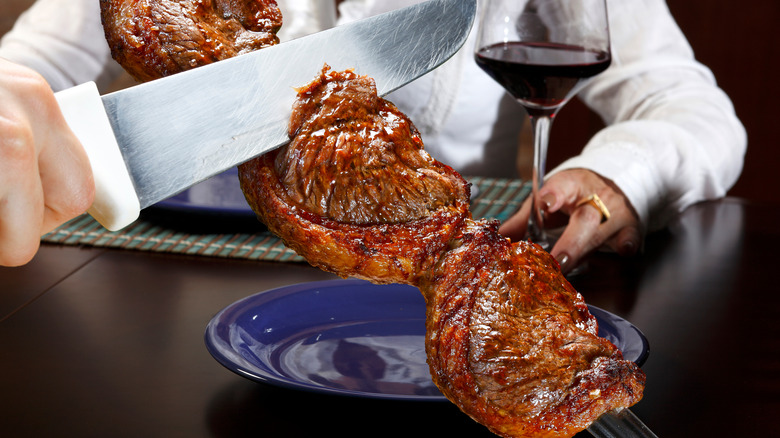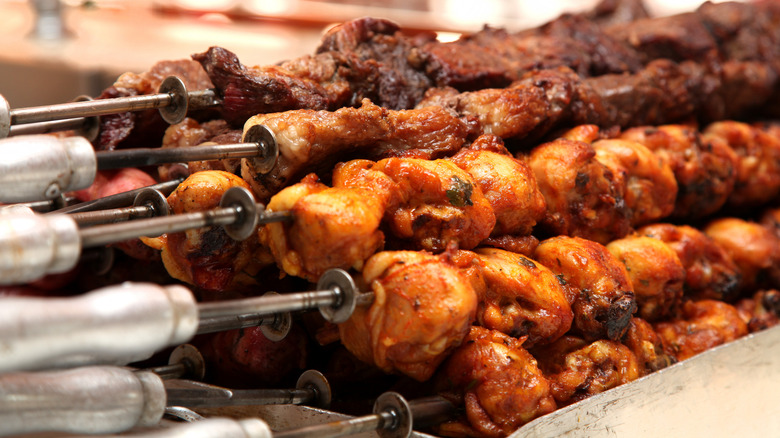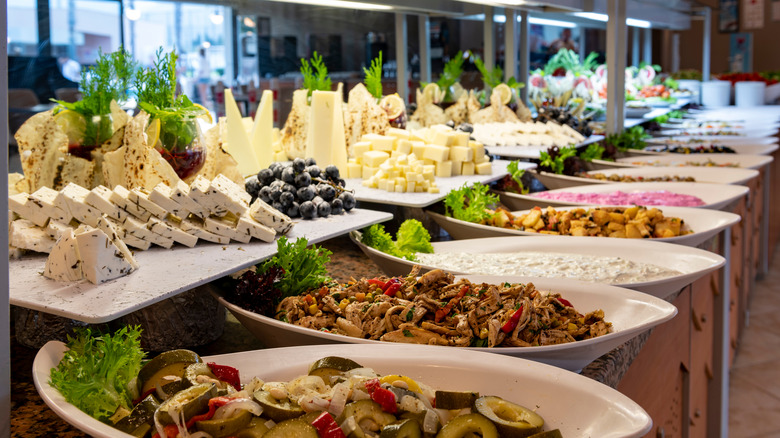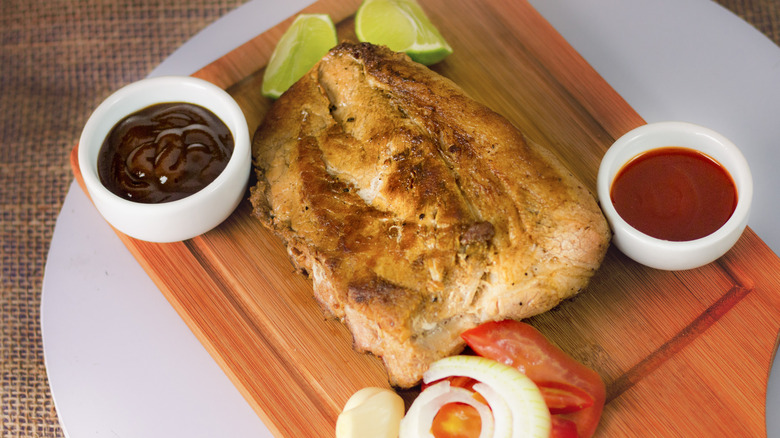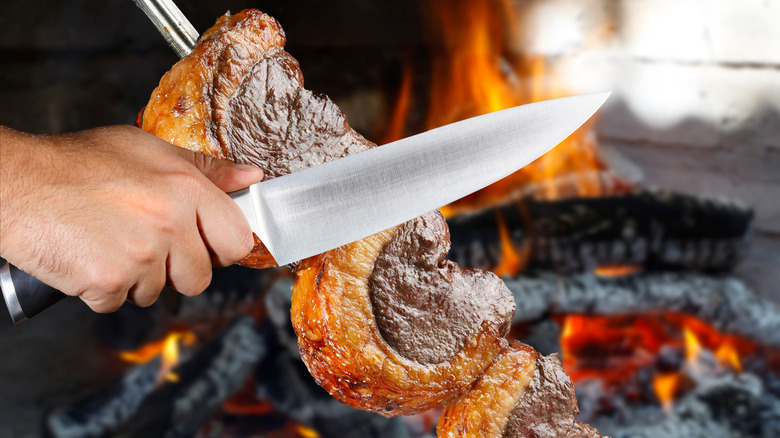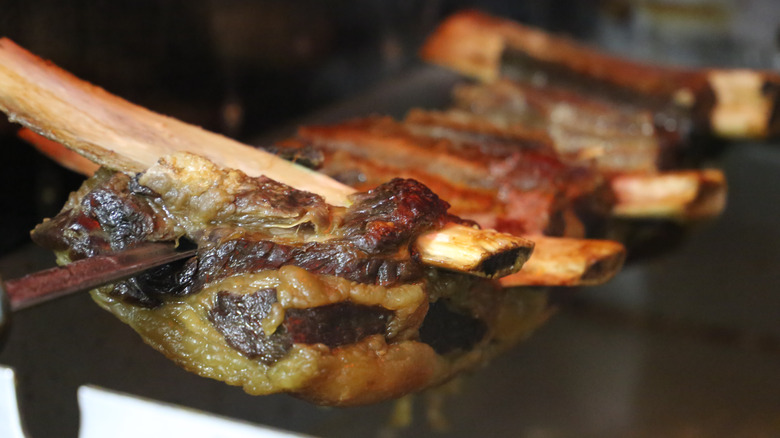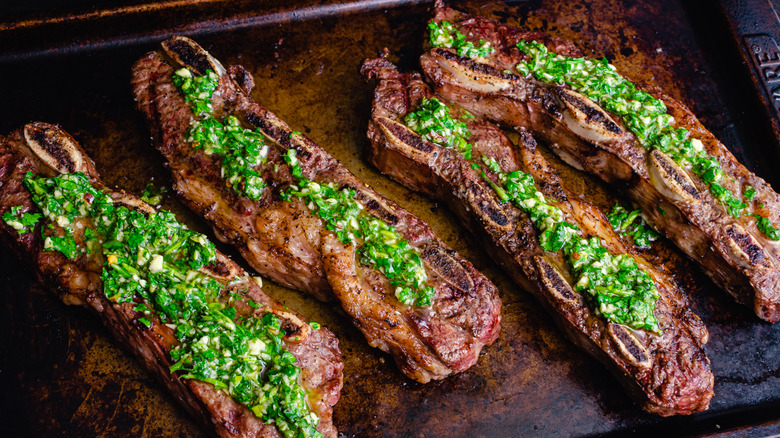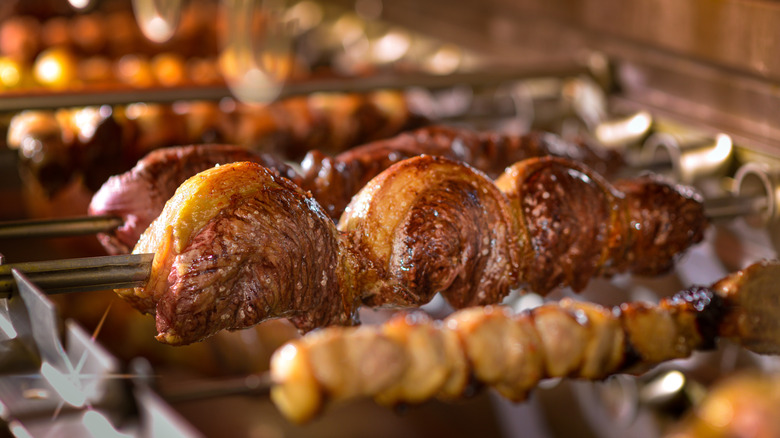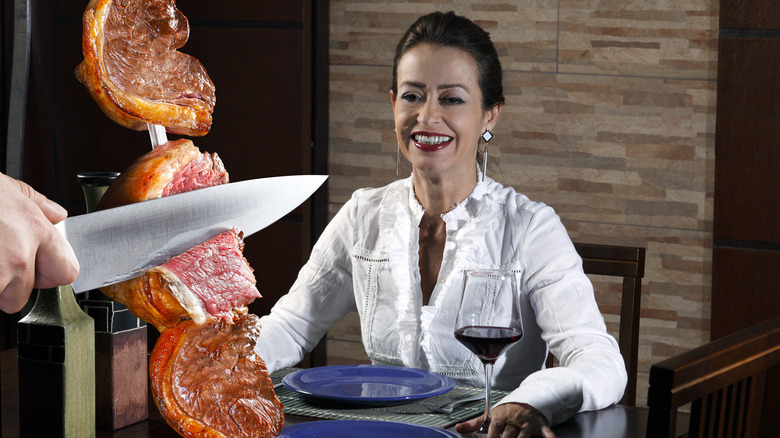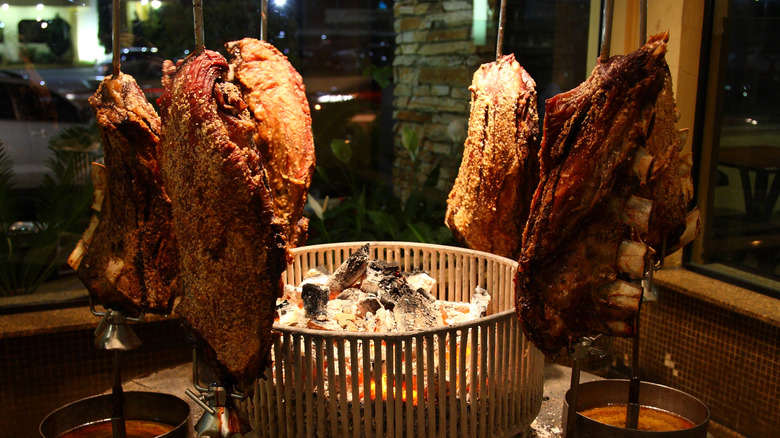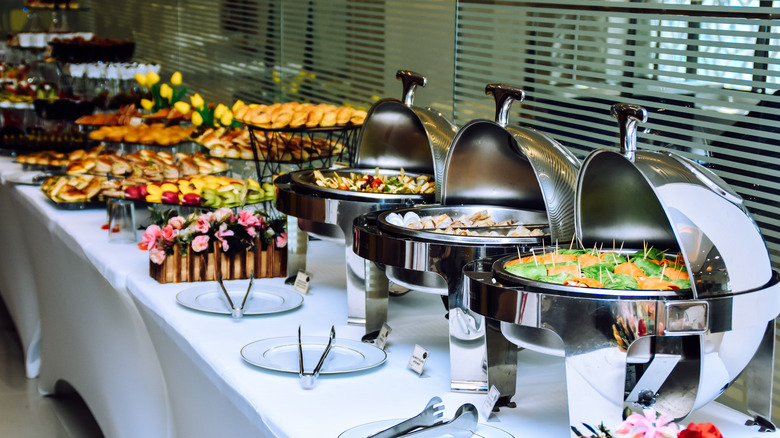Secrets About Brazilian Steakhouses You'll Wish You Knew Sooner
For serious carnivores, there's no better treat than a meal at a Brazilian steakhouse, or churrascaria. While other steakhouses may offer you an excellent steak, Brazilian steakhouses go the extra mile, offering not just one juicy cut, but as many servings of as many cuts as you like — along with unlimited side dishes — for a single fixed price. So if you're indecisive, hungry, and in the mood for meat, what's not to love?
But to get the most value and enjoyment from your Brazilian steakhouse adventure, you need to know what you're getting yourself into. You'll probably start your meal at the self-serve salad bar and buffet, which will typically contain everything from hearts of palm to candied bacon to charcuterie, according to the New York Daily News. But your meat will come to you — by tradition, skilled carvers (called passadores or gauchos) stroll the dining room bearing long, sword-like skewers of meat, from which they'll slice servings for you if you display a green card at your table (Displaying a red card means you're taking a break or are done eating). As you can imagine, all this can be confusing if you're not prepared. To ensure you have a great meal, here are some inside tips for planning and enjoying your Brazilian steakhouse meal.
Research the menu before you go
Make no mistake — a Brazilian steakhouse meal is a major undertaking (it should be your only significant meal of the day). And like any big project, it works best with some advance planning. First, reservations are recommended or required at most Brazilian steakhouses in the U.S. (as Man Tripping notes, Brazilian steakhouse meals are leisurely affairs, so tables don't turn over as quickly as at typical restaurants) — so schedule your feast in advance and remember to eat lightly before your visit.
To ensure you get to experience the best the restaurant has to offer, Man Tripping also recommends researching the menu before you go. This not only gives you an idea of what to expect but also alerts you to any specialty meat cuts or other special items that you may not see being served when you get there (Some restaurants serve certain cuts only upon request, or circulate them less frequently). As we'll get into later, Brazilian steakhouses serve a different selection of cuts than North American ones do, so even if you're a steakhouse veteran, you should do some research. Knowing what's on offer will allow you to politely pass up less-interesting items without worrying about going hungry — because you know better options will be on their way. You want every bite of food you eat during your visit to be the most delicious thing possible.
Plan your salad bar visit strategically
When you arrive at a Brazilian steakhouse, your host or hostess will typically seat you, explain how things work, then invite you to serve yourself at the salad bar (via Forbes). And if you've worked up an appetite and the smell of grilling meat is making you even hungrier, you may be tempted to load up on the many items on display — this salad bar experience is nothing like the sad iceberg lettuce and cherry tomatoes you might remember from your childhood visits to Wendy's. Brazilian steakhouse salad bars offer everything from marinated mushrooms to sushi to the classic Brazilian black bean stew feijoada according to New York Daily News.
Tempting as this is, filling up on the salad bar is a rookie move to be avoided at all costs. After all, every bite dedicated to sushi (in a steakhouse — really?) means less room for what Brazilian steakhouses do best — tender meat skillfully grilled over an open fire. And since Brazilian steakhouse meals are a bit pricy (an all-you-can-eat dinner at the popular chain Fogo de Chao's Orlando restaurant is $60.95), you'll get the most from your investment by focusing on specialties you can't get elsewhere and select side dishes you truly love. So when at the salad bar, look before you leap. The New York Daily News recommends walking around the whole serving area to see all the offerings before making your choices.
Go early — but not too early
Timing matters when planning your Brazilian steakhouse meal. First, to ensure a relaxing and enjoyable experience, be sure you've set aside enough time for a leisurely meal — as the New York Daily News notes, you'll enjoy your meal more if you eat slowly, take smaller portions, and give yourself permission to take breaks between bites. Also, if you give yourself more time, more room might open up in your stomach, allowing you to achieve your goal of eating as much meat as possible. Diners posting on TripAdvisor recommend at least 1.5 hours, ideally 2 or even more, for a Brazilian steakhouse meal.
And the time you choose to dine matters too. As Man Tripping notes, gauchos — like athletes — need some time to warm up and get into peak performance mode each day. Thus, you may not experience them at their best if you're the first table through the door at the beginning of a meal shift. Furthermore, the busier the restaurant gets, the faster fresh skewers come out — so you may get fresher meat during peak dining hours. Finally, the busy hours are the time when a greater variety of meats, including special cuts and seasonal items, will be in circulation. So don't rush to get the first reservation of the evening. But don't go too late either, or the good stuff you've been looking forward to may have already run out.
Avoid carbo-loading
At standard steakhouses, rich, starchy sides are part of the attraction — who doesn't love fluffy mashed potatoes, creamy macaroni and cheese, or a crisp-edged potato gratin? Not only are they tasty in their own right, but they're a great foil for a good cut of beef. Brazilian steakhouses are no exception. They offer an even wider assortment of carb-heavy side dishes than standard steakhouses. Besides potatoes and mac and cheese, you'll often get Brazilian specialties including fried bananas and pao de queijo, a type of cheesy pastry puff, according to Fly and Dine. And because Brazilian steakhouses are all-you-can eat affairs, you can have as much as you like of any or all of them.
But beware — this bounty of starches is both a blessing and a curse. If you come to the meal hungry (which you should) it's way too easy to fill yourself up on cheesy, starchy delights before the first skewer of meat gets to your table. And that would be a serious mistake — you're not paying the big bucks to feast on potatoes and bananas. So choose your sides strategically — Fly and Dine recommends dedicating no more than 20% of your meal to side dishes. The sides are there to act as an accompaniment to the main event, not to be your whole meal.
Pace yourself
The dizzying number of options and bustle of activity in a Brazilian steakhouse can be overwhelming, and you may feel rushed to grab a serving of everything at once and take every cut of meat that comes to your table. Don't. Remember, your Brazilian steakhouse experience is supposed to be a leisurely meal, not an eating contest. So it's up to you how much you eat, and how fast. As chef Bobby Flay advised the New York Daily News, "Moderation is really key. I'd rather have lots of little bites of lots of things than gorge myself in one big meal."
This means you shouldn't feel any pressure to accept every bit of meat that comes your way — it's perfectly acceptable to politely decline anything that doesn't interest you. And if you see something that looks good, but your plate is already full, give it a pass. As Man Tripping advises, you want to enjoy your meat when it's as hot and fresh as possible, so enjoy the food in front of you before loading up again. And don't worry: A fresh batch of that tempting morsel will no doubt be there for you when you're ready for seconds. If you don't see it walk by again, you can always try requesting it from a passing gaucho.
Save room for the good stuff
In Brazilian steakhouses, as in life, the ability to work towards delayed gratification will take you far. Remember, no matter how frenzied the scene around you — and how fast and how much others seem to be eating — you are, in reality, in no rush. And strategic choices early in your meal will not only allow you to avoid indigestion later, but give you access to better stuff.
Why? According to Man Tripping, there's a good chance that not every meat option will be circulating when you're first seated, especially if you arrive early in the meal service. This is especially true of specialty (and more expensive) items, which often aren't brought out until later in the service, according to Groupon. Thus, if you get excited and load up on routine cuts, tasty as they may be, early in the meal, you may be too bloated to really appreciate the really special stuff when it comes out — or worse, you may already be out the door. So take your time, keep your eyes open, and you'll reap the rewards.
Tangy sauces are an authentic — and refreshing — part of the experience
For some steak connoisseurs, sauces may seem like a tangential or even unnecessary part of a steakhouse meal — after all, one goes to a steakhouse to enjoy the flavor of meat, not cover it up. Of course, some sauces, like ketchup, should never go on a steak. But if you go to a Brazilian steakhouse, you should give the sauces a shot — they're an authentic and refreshing part of the Brazilian steakhouse experience.
And if you find the standard butter-based sauces of most U.S. steakhouses too rich and stodgy, the light, tangy, uncooked vegetable-based sauces in Brazilian steakhouses may be a revelation. One of these is molho campanha, a vibrant vinaigrette flavored with chopped tomatoes, onions, and green peppers. Another popular accompaniment is chimichurri, a fresh green sauce with parsley, cilantro, garlic, and citrus or vinegar. Both are intended to not only enhance the flavor of meat, but serve as an invigorating foil to it. The acid in these sauces helps cut through the richness of all the beef fat and salt you'll be consuming during your visit to the churrascaria. They also help ensure your palate will be refreshed for your next serving.
Know your Brazilian meat cuts
A potentially intimidating factor if you're new to Brazilian steakhouses is the meat menu. Besides standard favorites such as filet mignon and ribeye, along with non-beef options including chicken, pork, and lamb, you'll almost certainly see some less familiar — if not completely unfamiliar — cuts with Portuguese names. And if you don't know what these are or how they're pronounced, you may be tempted to skip them altogether.
Don't be intimidated by these unfamiliar cuts. If you skip them, you'll be missing out on some of what makes a Brazilian steakhouse meal truly distinctive and special. According to Taste Atlas, a must-try cut that's central to the Brazilian steakhouse tradition is picanha, or rump cap — a lean cut topped with a layer of fat that keeps the meat juicy. Other popular cuts are fraldinha, or long strips of flank steak, and alcatra, a large, fat-capped cut of top sirloin. Another popular cut unique to Brazilian steakhouses is cupim, which comes from the hump of Brazilian Zebu cattle. This richly marbled cut is not often served in the U.S., but should you visit a steakhouse in Brazil (or find the rare U.S. restaurant offering it), it's well worth seeking out.
Let your gauchos be your guides
When in doubt at a Brazilian steakhouse, turn to the experts — and no one around will have more expert knowledge than the gauchos who will be carving and serving your meat. After all, they know the menu inside and out and know what's going on in the kitchen during their shift, so they can tell you what to expect, when certain cuts will be served, or what special dishes or meat cuts may be available. And if you have any questions about anything on the menu, they're the ones with the answers. Furthermore, according to Fly and Dine, gauchos can also set you up with meat cuts at your preferred level of doneness as well as other special requests.
This makes it all the more important that you get on your gauchos' good side. Of course, all service industry workers deserve to the treated with respect, but gauchos in Brazilian steakhouses are your gatekeepers and guides, so it's worth your time to let them know you appreciate their expertise. And they will appreciate your gratitude, since strolling around a busy dining room bearing a big skewer of meat all night is harder than it looks — the popular Brazilian steakhouse chain Fogo de Chao estimates its gauchos walk an average of six miles a night during their shifts.
Don't worry about getting dressed up
A Brazilian steakhouse meal may be a pricy special-occasion event for most diners — but it's far from stuffy. So if you're celebrating something really special, go ahead and dress to the nines for your feast (many people do). But if you don't feel like getting dressed up, no worries — while dress codes at Brazilian steakhouses in the U.S. vary from restaurant to restaurant, they generally range from business casual to come as you are. The chain Texas de Brazil, for example, notes that jeans are perfectly acceptable to wear while dining there. Similarly, Fogo de Chao has no set dress code, but says business casual is appropriate at most of its locations. And the chain Brazeiros says that it appreciates when guests dress up, but ultimately will accept diners dressed in comfortable clothes.
Whatever you wear, however, remember you'll be eating more than usual, so it's a good idea to avoid wearing anything too tight or constricting. And depending on your wardrobe, this may impact your choice of an outfit for your meal. As a commenter on a Yelp thread on Brazilian steakhouse dress codes wrote, "Why would anyone dress up to an AYCE? I go there with an empty stomach and come out 10lbs heavier :D. I have no plans to impress anyone there while I'm shoveling down big chunks of picanha."
Micro-servings are the key to a varied meal
If you have a smallish stomach but endless curiosity about what's on all those skewers circulating around the dining room, don't despair — with a bit of planning and discipline, you can indeed try them all. The secret, according to the New York Daily News, is to ask for and take tiny portions. This is perfectly acceptable, and don't worry, your server won't be offended. "Ask for little pieces when you're not sure if that's going to be your favorite," chef Vanderli Melchior advised the New York Daily News. He added that if you fall in love with a certain cut, you can always ask for seconds.
The same holds for other portions of the meal. Serious carnivores know it's smart to avoid filling oneself up at the salad bar, but that doesn't mean you should pass it up completely. After all, an all-meat meal can get old pretty fast, and as the New York Daily News notes, Brazilian steakhouses have some pretty enticing items at their salad bars. So to get the most varied experience without overeating, help yourself to little bites of whatever appeals to you.
